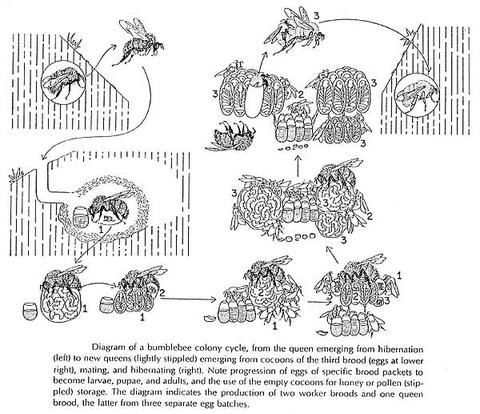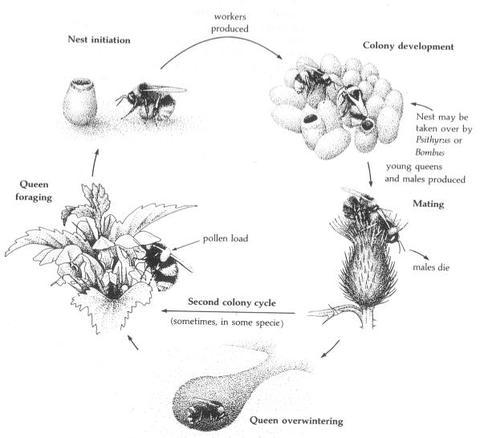The genus Bombus belongs to the family Bombinae and includes about 226 described species of bumblebees. In the Iberian Peninsula are 28 species for this genus.
Description.
- Females: are big and have strong, arched and wide jaws (overlapping at rest). The labrus is rectangular with two tubers. The hind tibiae are flat and in its dorsal part hairless. The hair covering the ventral and lateral tibia are the pollen baskets. In the hind legs the tibio tarsal is concave and is flanked with bristles. The function of these bristles is to collect pollen and take it to the corbiculae or pollen baskets.
-
Males: have a fine style dots in triangular head. Antenna cloaner is long (around one third the size of the flagellum). The tibias are brilliant because they just have dotted and are widened distally. The males do not have sting.
In general, the genitalia is very sclerotic.
Reproductive cycle
Most bumblebees form colonies annually. In late summer or autumn, fertilized young queens overwinter and emerge in spring. Then, they form a new colony.
When the queen emerges looking for a place to nest (which varies in each species). After that, queen builds two bowls, usually coated with wax. A bowl full of pollen, in which lays eggs. In another bowl, reserves of honey serve as food for the larvae. Shortly after (one week in Bombus pascuorum), the larvae begin to weave a cocoon around. After pupation, Queen reuse the wax.
About a month after commissioning, the first workers will hatch. The workers are responsible for the care of laying and the queen is dedicated only to lay eggs. Gradually, the colony is increased. In late summer-early autumn, the females that hatch out, have reproductive organs fully developed. These females mated with males that appear simultaneously and be fertilized.
The fertilized females overwinter and they will be forming new colonies the following year.


There are associated behaviors to each of the two major phylogenetic groups of Bombus. The species of long-tongued bumblebee (such as Bombus pascuorum) pollen stored in the side pockets to feed the larvae. While short-tongued bumblebee species, in general, deposit pollen on wax vessels or cells (such as Bombus pratorum) See Phylogeny.
Below, we exposed an example of reproductive cycle in the case of a bumblebee long-tongued and another example of a bumblebee short-tongued exposed.
- Bombus pascuorum. In spring, the fertilized queen looking for nesting area, where it forms a hollow ball of moss. Then, it builds two bowls around 5 mm. The queen fills a bowl placed pollen and eggs between 5 and 15 and closes the bowl. The other bowl, it fills of nectar for possible scarcity situations. The larvae hatch in 3-5 days and feed on pollen reserves. A week later, the larvae begin to weave a cocoon around. Pupation lasts 1 or 2 weeks, after which the first workers hatch.
-
Bombus pratorum. There are two main differences between Bombus pascuorum y Bombus pratorum. On the one hand, in Bombus pratorum, there is a long period of time between the emergence of the queen and the nesting. And moreover, the queen of Bombus pratorum is placed above the first lay and it vibrate muscles to increase the temperature ("incubated" eggs).
A few species of the genus Bombus are thought to be bumblebees parasites. Bumblebees parasites have no laborers, but they have males and females. After overwintering, one fertilized female invade the nest of another species and destroys part or all of the eggs. Then, female puts her own eggs and goes. The workers of the host species take charge of the care and feeding eggs.